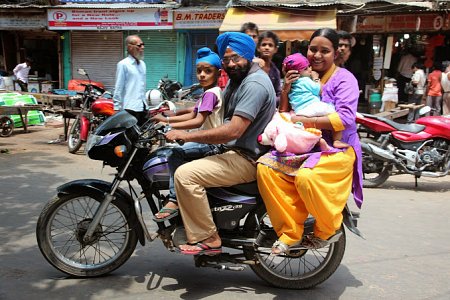The Way of the Way
It has just been announced that an ancient yoga text, Marga margasya (‘The Way of the Way’) dated 8thcentury AD(?) was recently discovered in a remote cave in the Himalayas. Experts believe this will shed invaluable light on the strange habits of Indian road users. The text appears here for the first time, translated from Sanskrit by our Cultural Director:
Verse 1: As we are in truth immortal spirit, so all road users should drive accordingly.
Verse 2: As we must respect the hierarchy of beings, so precedence must be given in this descending order: cows, elephants, water-buffalo, camels, heavy trucks, buses, official cars, light trucks, auto-rickshaws, private cars, motor bikes (carrying four or more), pedal rickshaws, goats, bicycles (carrying three or more), pigs, dogs, pedestrians.
Verse 3: As only the strong succeed, so for wheeled vehicles to slow is to show weakness, to brake is to fail and to stop is to be defeated.
Verse 4: As sound is divinely creative, so using the horn is compulsory, as:
- Cars: Short blasts (urgent) indicate supremacy, e.g. in clearing dogs, rickshaws and pedestrians from the path. Long blasts (desperate) denote supplication, e.g. to oncoming truck: ‘I am going too fast to stop, so unless you slow down we shall both die’. In extremis, they may be accompanied by flashing of headlights (frantic). Single blast (casual) means: ‘I have just seen someone out of India’s 1200 million inhabitants I recognise’, ‘It is Lord Krishna’s birthday soon’ or ‘I have not blown my horn for several minutes’.
- Trucks and buses: All horn signals mean the same, i.e. ‘I have a full weight of about 12.5 tons and have no intention of stopping for anything whatsoever, even if I could’. This signal may be accompanied by turning headlights on full in the face of approaching vehicle.
Verse 5: As the action of the enlightened is spontaneous, so all manoeuvres and evasive action shall be left to the last possible minute.
Verse 6: As guests are always to be honoured, so car occupants shall substitute safety belts with garlands of marigolds, to be kept unfastened at all times.
Verse 7: As we should always follow the noble Middle Way, so traffic shall not drive on the left, nor on the right, but in the centre of the road.
Verse 8: As the round of samsara is an illusion, so roundabouts do not really exist in India. Apparent traffic islands in the middle of the road should be ignored as a sensory hallucination unhelpful to true understanding.
Verse 9: As all life is evolving, so overtaking is compulsory. Every moving vehicle is required to overtake every other moving vehicle, irrespective of whether it has just overtaken you. Overtaking should only occur in auspicious conditions, e.g. in the face of oncoming traffic, on blind bends, at junctions and in the middle of village and town centres on market day. No more than two inches should be allowed between you and the other vehicle; one inch in the case of bicycles and pedestrians.
Verse 10: As meditation and prayer are essential to the spiritual life, so all true seekers should close their eyes for regular periods of contemplation whilst driving.
Verse 11: As life does not go backwards, so no vehicle in India needs have a reverse gear.
Verse 12: As God moves in a mysterious way, so Kalki, the divine destroyer, may well come in the guise of an articulated oil tanker.





